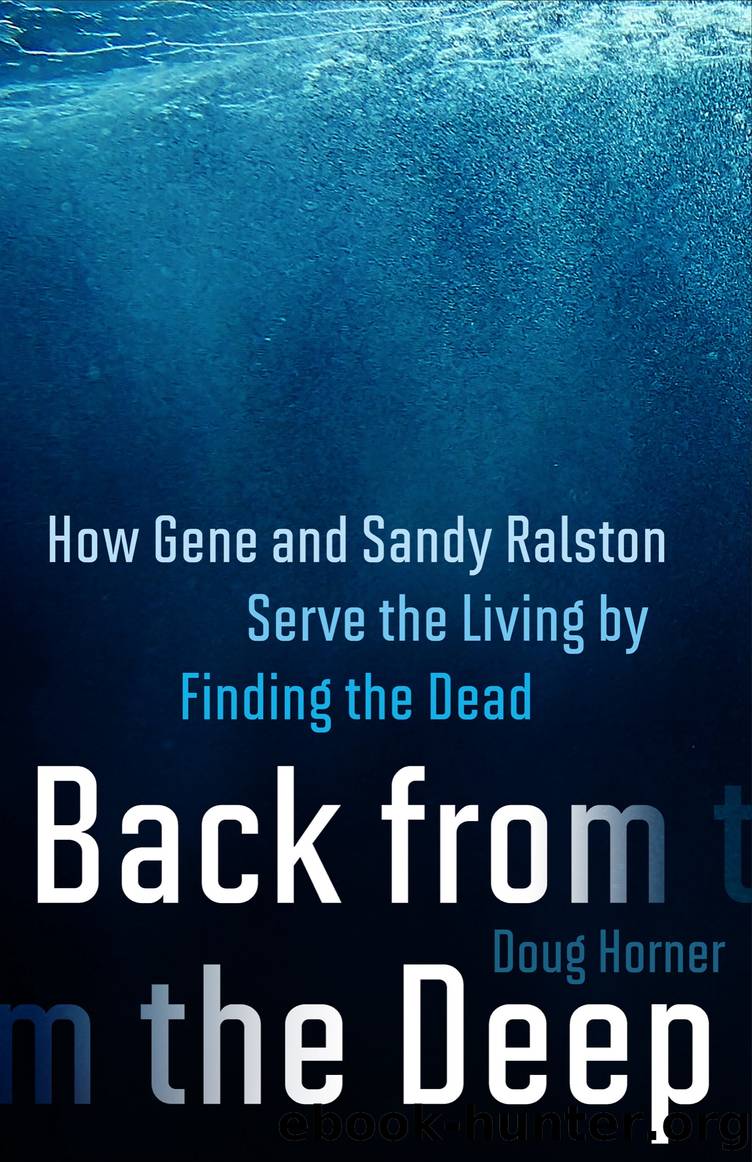Back from the Deep by Doug Horner

Author:Doug Horner [HORNER, DOUG]
Language: eng
Format: epub
Publisher: Steerforth Press
Published: 2024-03-12T00:00:00+00:00
CHAPTER TWELVE
A Body at Rest Tends to Stay at Rest
Robert Teather wrote The Encyclopedia of Underwater Investigations for public safety divers, the people who work with the police to find evidence and corpses in water. The book included an entire chapter about postmortem physiology. Itâs crucial for these divers to understand how the human body decays because theyâre often the first to arrive at a potential crime scene. They need to know the difference between natural decomposition and any injury or artifact that is a sign of something criminal.
The sights and smells of putrefaction often inspire a deep-seated sense of revulsion. Itâs hard not to react, but thatâs precisely the job of public safety divers. Itâs up to them to report on submerged bodies in detail and with objectivity. Teather coached his readers to âlook beyond the sometimes horrific appearance caused by natureâ by reminding them that decay is a natural stage in the cycle of life. Even scavengers, Teather wrote, play an honorable role by speeding the process up and minimizing the spread of bacteria.
Something about the care that Teather took in his book to guide and counsel his colleagues deepened my appreciation for the different ways that the Ralstons have to think about corpses. Like public safety divers, they rely on a detailed understanding of how a body behaves like an inanimate object in the water. And searches can sometimes take on the feel of a treasure hunt or a quest to solve a mystery. But Gene and Sandy develop close bonds with the family of the missing person and learn all about who, instead of what, theyâre trying to find.
Mary Roach wrote about the dual nature of corpses in her book Stiff, which is about the manifold ways that human cadavers have contributed to advances in medicine and other fields. The dead of science, Roach wrote, are always strangers. Anonymity is a precondition for the doctors and scientists who work with and study corpses. âI would not want to watch an experiment, no matter how interesting or important, that involved the remains of someone I knew and loved,â she wrote. âI could not, emotionally, separate that cadaver from the person it recently was. Oneâs own dead are more than cadavers, they are place holders for the living. They are a focus, a receptacle, for emotions that no longer have one.â
The historian Thomas Laqueur worked to answer the seemingly simple question of why bodies matter in his book The Work of the Dead: A Cultural History of Mortal Remains. Laqueur sets his book up as a challenge to the ancient Greek philosopher Diogenes and his argument that corpses are no more valuable than a worn-out piece of furniture. Diogenes told his friends that in the event of his death, they should toss his still-warm body over the city walls to be devoured by wild animals without ceremony or delay.
We can respect the logic of Diogenesâs argument, Laqueur wrote. It rings true, at least in a superficial way. We
Download
This site does not store any files on its server. We only index and link to content provided by other sites. Please contact the content providers to delete copyright contents if any and email us, we'll remove relevant links or contents immediately.
Cecilia; Or, Memoirs of an Heiress — Volume 1 by Fanny Burney(31353)
Cecilia; Or, Memoirs of an Heiress — Volume 3 by Fanny Burney(30951)
Cecilia; Or, Memoirs of an Heiress — Volume 2 by Fanny Burney(30908)
The Great Music City by Andrea Baker(21637)
We're Going to Need More Wine by Gabrielle Union(18088)
Bombshells: Glamour Girls of a Lifetime by Sullivan Steve(13120)
Pimp by Iceberg Slim(12949)
All the Missing Girls by Megan Miranda(12779)
Fifty Shades Freed by E L James(12465)
Talking to Strangers by Malcolm Gladwell(11910)
Norse Mythology by Gaiman Neil(11904)
Crazy Rich Asians by Kevin Kwan(8374)
Mindhunter: Inside the FBI's Elite Serial Crime Unit by John E. Douglas & Mark Olshaker(7851)
The Lost Art of Listening by Michael P. Nichols(6485)
Enlightenment Now: The Case for Reason, Science, Humanism, and Progress by Steven Pinker(6416)
Bad Blood by John Carreyrou(5784)
The Four Agreements by Don Miguel Ruiz(5534)
Weapons of Math Destruction by Cathy O'Neil(5049)
We Need to Talk by Celeste Headlee(4882)
